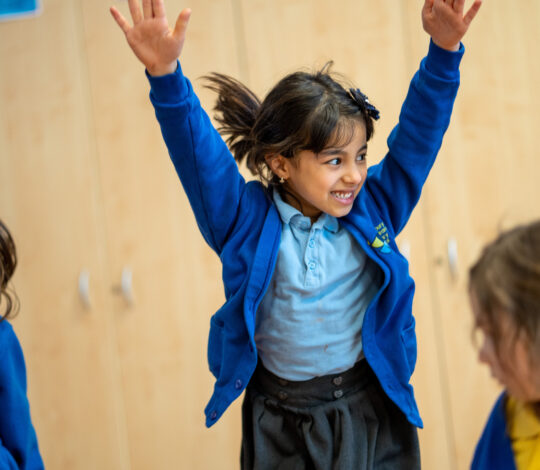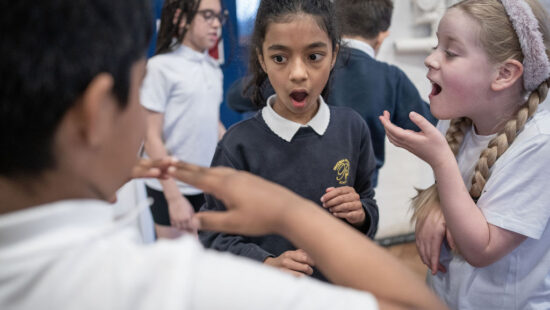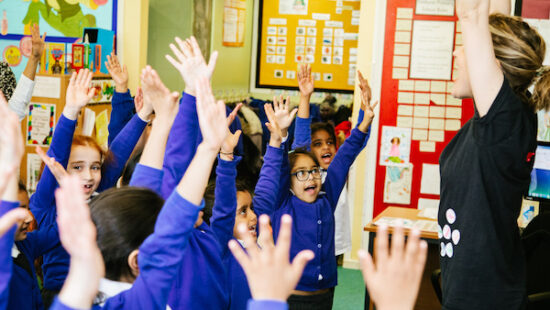10 Creative ways to teach literacy

10 Creative ways to teach literacy
Because literacy is so important in the primary curriculum, there are all sorts of tried-and-tested strategies, such as the use of synthetic phonics and guided-reading, which have become essential components of teaching. These methods are very effective, but using a variety of approaches can help maintain the children’s interest in their work, and the performing arts provide a buoyant, enjoyable platform from which to do this.
Happily, you don’t need a wealth of performing arts experience to give these ideas a go, and you might find you give children who struggle with reading and writing a chance to shine in literacy lessons.
Story Whoosh
There’s no better way to introduce children to a story than to have them perform it. In a Story Whoosh the children sit or stand in a circle, whilst the teacher narrates the story. As the tale unfolds the children enter the circle when invited and take on the characters and perform the actions described by the teacher. Children can also play any animals, objects or buildings that appear, and add sound effects and dialgoue! The ‘Whoosh’ comes at the end of each section, when the teacher waves a wand or stick in the air, making a ‘whoosh’ sound, to indicate all children to return to their places. This activity is a great way for the children to imaginatively contribute to an existing narrative, as well as making the story really stick in their heads.
Singing Recipes
For non-fiction writing, particular any kind of instruction based work, a song can greatly help the children remember the stages of a process. I was recently involved in a school project in which the children made toffee apples, with a view to writing up the process. Before the children set pen to paper, we wrote a song together, with two lines describing each stage, and a chorus linking the sections. This really cemented the steps for the children’s writing, as well as providing a lovely, whole-class activity before the individual writing task. If you’re not a song-writer, just change the words to an existing song – it works just as well.
Character Statue-Gallery
This activity is a great way for children to creatively explore characters from a story, perhaps as preparation for a character description task. The children are in pairs, with one as the statue, and the other as the statue-maker. One child then carefully moulds the other into a stance of the given character, not forgetting the facial expression! When finished, put on some background music, and have half the class walk round the statue gallery, before swapping over. You can then gather descriptive vocabulary to feed into the writing task.
Acrostic Rapping
We’re all familiar with acrostic poems, but this approach can give the formula a new lease of life. Give the children the extra challenge of making each line of their poem scan rhythmically, turning it into a rap. This can be done as a whole class, or, if the children are more able, in small groups. Put a backing track on and away you go! A nice additional touch is to have the children say the letter name before rapping the line, which will also help them remember the spelling.
Sound Story
Another technique that allows children to creatively explore narratives is this musical composition task. Split a story up into four or five key moments, which can then form the structure for an original composition using percussion instruments. First gather vocabulary appropriate to the story, maybe adjectives describing characters, or the emotions or atmospheres present. You can then use this vocabulary to explore the instruments as a class; can you make a ‘nervous’ sound on the tambourine; how about a ‘thrilling’ sound on the cymbal, or a ‘brave’ sound on the wood-block? The children can then evoke the mood or actions of a given section of the story in small groups, which could then form part of a class assembly, as well as giving the children a deeper understanding and connection to the action.
Our final 5 tips on how to teach literacy through the performing arts will give you even more ideas about how to bring literacy to life in your classroom. If you haven’t yet seen the first 5, click here to see our previous blog.
Kung Fu Punctuation
This popular technique will certainly make grammar lessons more enjoyable and memorable. Assign each element of punctuation with a movement and Kung Fu vocalisation (e.g. full stop = make a fist, punch the air and say “Hi-Ya!”). Practice these until the children know them, and can perform the movements and sounds on command. You could then place an unpunctuated sentence on the whiteboard, read through as a class, and ask the children to perform the sounds and actions where they think the punctuation should appear. To help you get the idea, have a look at this video of a Yr 4 class practicing their Kung Fu moves!
Living Comic-Strip
How well do the children know a given story? Test their memory and ability to sequence a narrative with a living comic-strip. Each group must express the key moments of a story by creating a series of dramatic tableaux; each tableaux can contain direct speech or a caption, as in a real comic-strip. In performance, you can separate each ’tile’ of the comic strip by banging a drum, or giving another aural signal. This can be great preparation for writing a story summary, or creating an actual comic-strip.
Spelling Dance
There are certain words which children frequently spell incorrectly, but by giving the children a kinaesthetic link to the letters in those words, this can be overcome. In the school hall, write the problematic word in large letters for the whole class to see. Ask the children to write the word in the air in front of them; they can then try writing it with different parts of the body (e.g. imagine you have a pen stuck to your nose, your knees, etc.) and create their own movement sequence based on the letters of the word. Add a backing track, and you have your own original ‘spelling dance’.
Talk Show Host
This variant on hot-seating allows children to explore characters and interrogate their motivations. Go into role as the host of a talk show, and welcome different characters onto the ‘sofa’ to be interviewed. You can add drama to this by gradually increasing the number of characters on the ‘sofa’, in the style of Jeremy Kyle, and stoke disputes between them! When the children are comfortable with the format, they can try this independently, in small groups.
Dance the Story
Here is another activity that can help children sequence a given story, or identify the key sections of their own compositions. Ask the children to split the story into parts, and create a mime or gesture to summarise each section. This can be turned into an expressive movement piece by adding music, and simple transitions between each gesture. Perhaps the children could create their work in pairs, with one child narrating each section as the other performs the movement.
If you’d like to chat with a member of the team to explore whether Artis might be right for your school, please email: dingdong@artisfoundation.org.uk or call us on 0207 324 9880.

